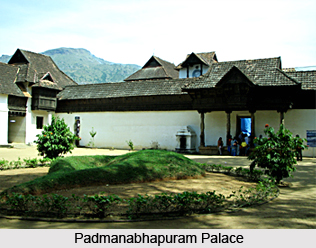 The monuments of Trivandrum are of great historical significance. Trivandrum or Thiruvananthapuram is located in Kerala, at the South western tip of India. It combined with Cochin and became the capital city of Kerala in 1956. Though the palace is situated in Kanyakumari district of Tamil Nadu, it comes under the purview of the Government of Kerala`s administration.
The monuments of Trivandrum are of great historical significance. Trivandrum or Thiruvananthapuram is located in Kerala, at the South western tip of India. It combined with Cochin and became the capital city of Kerala in 1956. Though the palace is situated in Kanyakumari district of Tamil Nadu, it comes under the purview of the Government of Kerala`s administration.
Trivandrum occupies a prominent position in the tradition literature and folklore of the period. The Ays were the leading rulers here till the 10th century AD. They were sacked and defeated by the Chola army, and their place was now taken by the Venads.During the regency of Umayamma Rani, the British East India Company acquired a stretch of land at Anchuthengu, on the sea coast about 32 km`s north of Thiruvananthapuram city intending to set up a factory and fortify it. From here they gradually extended heir domain to other parts of Travancore. Maharaja Marthanda Varma is regarded as the father of modern Travancore
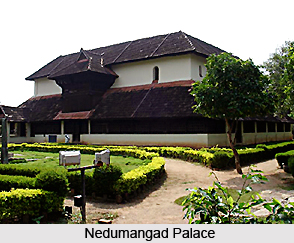 Trivandrum is said to have modernized under his rule. The city today is a large, rambling city dispersed across a series of lush forested hills on the edge of the Arabian Sea. It retains a strong vernacular character, with red-tiled roofs and a common local architectural style.
Trivandrum is said to have modernized under his rule. The city today is a large, rambling city dispersed across a series of lush forested hills on the edge of the Arabian Sea. It retains a strong vernacular character, with red-tiled roofs and a common local architectural style.
Most of the monuments here are very typically native in their construction. There are few Islamic or European buildings of any great interest.
Historical Monuments Of Trivandrum
Padmanabhapuram Palace is a magnificent wooden palace of the 16th century, located in Thuckalay, 64 km from Thiruvananthapuram. It is the old palace of the Rajas of the erstwhile Travancore (1550 to 1750 AD) and an excellent example of the indigenous architectural style of Kerala. The palace has antique interiors replete with intricate rosewood carvings and sculptured d‚cor adorned with 17th and 18th century murals. There are a number of beautiful sights to behold within the palace-windows with colored mica, a musical bow in Mahogany, royal chairs adorned with Chinese carvings and much more. The Queen`s Palace or Thaikkottaram is a resplendent affair with painted ceilings, rose wood and teak carved ceilings with over 90 different floral designs.
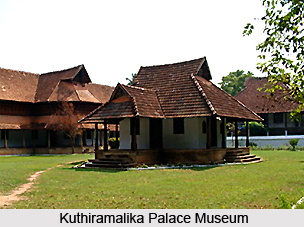 The Durbar Hall has a shiny black floor especially made with a combination of jaggery lime, egg white, burnt coconut, river and charcoal, secret underground passages, granite tubs to cool curd and buttermilk. hanging brass lanterns lit continuously since the 18th century, room for scribes and accountants, the King`s bedroom with a four poster medicinal bed, hanging cage through which eagles tore criminals to death, open air swimming bath, pooja (worship) rooms with jackfruit tree columns, fish carvings on the ceilings, enormous teak beams, Belgian mirrors and an outer cyclopean stone wall fitted together without mortar, granite dance hall, Goddess Saraswati (goddess of knowledge) temple, large earthen urns and room for scribes and accountants.
The Durbar Hall has a shiny black floor especially made with a combination of jaggery lime, egg white, burnt coconut, river and charcoal, secret underground passages, granite tubs to cool curd and buttermilk. hanging brass lanterns lit continuously since the 18th century, room for scribes and accountants, the King`s bedroom with a four poster medicinal bed, hanging cage through which eagles tore criminals to death, open air swimming bath, pooja (worship) rooms with jackfruit tree columns, fish carvings on the ceilings, enormous teak beams, Belgian mirrors and an outer cyclopean stone wall fitted together without mortar, granite dance hall, Goddess Saraswati (goddess of knowledge) temple, large earthen urns and room for scribes and accountants.
Nedumangad Palace also known as Koikkal Kottaram is an18th century palace situated about fourteen kilometers from Thiruvananthapuram at Nedumangad. It is on the way to the Ponmudi hill station and the Courtalam waterfalls. The palace today houses a folklore museum and a numismatic museum as well.
The chief attractions here are the Palace, the numismatics museum and the folklore museum set up by the Department of Archaeology.
Originally built for Umayamma Rani of the Venad royal family, the palace is a double storied traditional nalukettu with slanting gabled roofs and an inner courtyard.
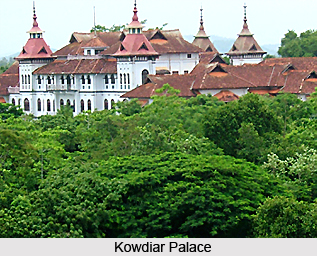 The folklore museum is a storehouse of occupational implements, models of folk arts, quaint musical instruments etc. There are some rare exhibits here a small percussion instrument used as an accompaniment while reciting the ballad Ramakathappattu (the story of Lord Rama) including the Chandravalayam (not found in any other such museum in Kerala); and Nanthuni, a sweet sounding musical instrument made of wood and string used while singing during Onam the harvest festival of Kerala. It also houses a number of household utensils as well as old manuscripts (Thaliyola), anklets (Chilambu) and dress materials made out of the bark of trees (maravuri) etc.
The folklore museum is a storehouse of occupational implements, models of folk arts, quaint musical instruments etc. There are some rare exhibits here a small percussion instrument used as an accompaniment while reciting the ballad Ramakathappattu (the story of Lord Rama) including the Chandravalayam (not found in any other such museum in Kerala); and Nanthuni, a sweet sounding musical instrument made of wood and string used while singing during Onam the harvest festival of Kerala. It also houses a number of household utensils as well as old manuscripts (Thaliyola), anklets (Chilambu) and dress materials made out of the bark of trees (maravuri) etc.
The Numismatics Museum at the Koyikkal Palace is the only one of its kind in the State. It is located in the ground floor of the palace, and houses coins from different parts of the world as well as to different eras. This rare and historically valuable collection is a legacy of the trade relations of the state in the bygone era.
Among the exhibits are some of the oldest coins of Kerala - Ottaputhen, Erattaputhen, Kaliyugarayan Panam etc. A Venetian coin named Amaida, believed to have been presented to Jesus Christ, is also a property of this museum. The most valuable among the Indian coins found here are `Karsha`. These are nearly 2500 years old. Also on display are the world`s smallest coins, rasi. Others include the Lakshmi varaham or the silver coins minted in Travancore, nearly 374 Roman gold coins, coins used by the various dynasties like the Nizams of Hyderabad, Gwalior royal family and even Tipu Sultan and Hyder Ali.
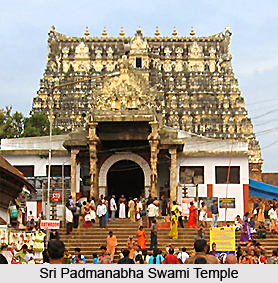 17 km south of Thiruvananthapuram city is Vizhinjam. There are rock-cut sculptures of the 18th century in the cave temple at Vizhinjam. The granite cave here encloses a one-celled shrine with a loose sculpture of Vinandhara Dakshinamurthi. The outer wall of the cave depicts half finished reliefs of the Hindu Lord Shiva with Goddess Parvati.
17 km south of Thiruvananthapuram city is Vizhinjam. There are rock-cut sculptures of the 18th century in the cave temple at Vizhinjam. The granite cave here encloses a one-celled shrine with a loose sculpture of Vinandhara Dakshinamurthi. The outer wall of the cave depicts half finished reliefs of the Hindu Lord Shiva with Goddess Parvati.
Kuthiramalika Palace Museum was built by Maharaja Swathi Thirunal Balarama Varma - the King of Travancore. He was a great poet, musician, social reformer and statesman. The architecture of the palace is a rare specimen of workmanship in the traditional Travancore style of architecture. It is adorned with also exquisite wood carvings. The palace museum displays paintings and various priceless collections of the royal family.
The Napier Museum was built in the nineteenth century in the Indo-Saracenic style of architecture. The museum has an interesting collection of archaeological and historic artifacts, bronze idols, ancient ornaments, a temple chariot and ivory carvings. The Napier Museum (1880), Zoological Gardens and Art Gallery form a complex in the park to the north of the city.
The Sree Chitra Art Gallery is located near the Napier Museum. The gallery displays select paintings of Raja Ravi Varma, Svetlova and Nicholas Roerich and exquisite works from the Rajput, Mughal and Tanjore schools of Art in India.
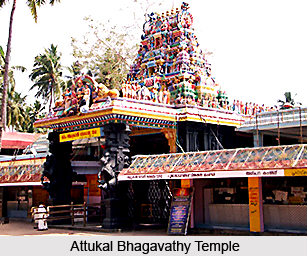 The Kowdiar Palace was once the home of Travancore Maharajas. In fact the last Raja Sree Chithira Thirunal Balarama Varma is buried in the beautiful garden of this palace.
The Kowdiar Palace was once the home of Travancore Maharajas. In fact the last Raja Sree Chithira Thirunal Balarama Varma is buried in the beautiful garden of this palace.
Kowdiar Palace`s architectural work is famous. However, entry to this famous palace, which has great historical importance, is restricted.
Religious Monuments Of Trivandrum
The Sri Padmanabha Swami Temple is situated right in the heart of the city of Thiruvananthapuram. The name of the city itself is derived from the name of the presiding deity. The temple is considered as one of the 108 Divya Desams (place of special holiness) of Lord Vishnu. The architectural work of the temple is famous. It is built in the Dravidian style and has 7 stories. The presiding deity is Lord Mahavishnu reclining on the Serpent `Anantha`. Different parts of the idol, namely, the face, the navel and the feet is seen from three door like openings The Travancore rulers were known as `Padmanabhadasan`, i.e., Servant to Sri Padmanabha Swami.
The most important festival of Sri Padmanabha Swami Temple is the Laksha deepam (one lakh lamps) which falls once in 6 years. During the festival, one lakh oil lamps are lit in and around the temple. Prior to the festival, recitation of the 3 Vedas are done in 56 days. The temple has been renovated a number of times and the last renovation was done by the Maharaja of Travancore Marthandavarma
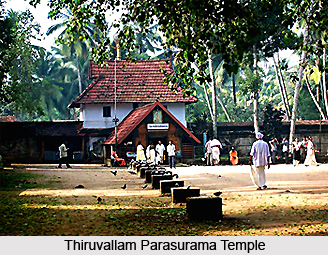 Aranmula Temple is located on the Thiruvananthapuram - Kottayam route. The temple is dedicated to Lord Krishna. A major attraction here is the snake boat race held as part of the Uthrettathi festival in August/September. "Aranmula Kannadi" is a hand made mirror of polished for which Aranmula is famous.
Aranmula Temple is located on the Thiruvananthapuram - Kottayam route. The temple is dedicated to Lord Krishna. A major attraction here is the snake boat race held as part of the Uthrettathi festival in August/September. "Aranmula Kannadi" is a hand made mirror of polished for which Aranmula is famous.
Attukal Bhagavathy Temple is located at Attukal, 2 km away from the city. The temple is considered as the Sabrimala of the women and they form the major portion of the devotees here. The goddess is worshipped as the Supreme Mother here.
Legend has it that Attukul Bhagvathy is the divinized form of Kannaki, an incarnation of Goddess Parvati. The Pongala festival is celebrated here in the month of March as a ten day long celebration. Kuthiyottam performed by boys and Thalappoli by girls are two popular rituals made on the Pongal day. A large number of devotees throng the temple during the festival times. The Pongal ceremony is exclusively for women.
The architectural style of the temple is a blend of Kerala and Tamil styles of architecture. There are beautiful carved figures of Mahishasuramarddini, Goddess Kali, Rajarajeswari, Sree Parvathi with Lord Paramasiva and various other depictions of the Goddess in and around the temple. The depictions of various other Gods and Goddess as well as the ten incarnations of Lord Vishnu are seen in the corridors of the temple. The ten incarnations of Lord Vishnu are also depicted here.
The Thiruvallam Parasurama temple is situated 10 km from Trivandrum on the Kovalam route. It is located on the banks of the river Karamana, and is the only one dedicated to Sri Parasurama. The temple dates back to the 12th-13th century, mainly the late Pandyan period.
Pilgrims visit this temple mainly for the Balitharpanam. It is believed that the renowned monk Adi Shankara made the Bali for his mother at this place. Offerings are made to the ancestors after taking a dip in the holy river.
Trivandrum abounds in a number of architectural constructions which stand testimony to the grandeur and engineering expertise of the various dynasties that ruled Trivandrum over the age.



















